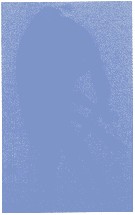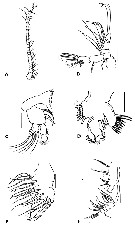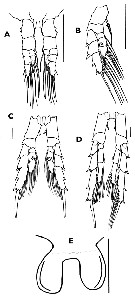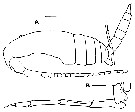|
|
 |
|
Calanoida ( Order ) |
|
|
|
Calanoidea ( Superfamily ) |
|
|
|
Paracalanidae ( Family ) |
|
|
|
Bestiolina ( Genus ) |
|
|
| |
Bestiolina sarae Dorado-Roncancio & Gaviria, 2019 (F,M) | |
| | | | | | | Ref.: | | | Dorado-Roncancio & al. 2019 (p.4, Descr. F, M, figs. F, M, Table 2, 3: Distribution & comparison between female species of the genus; key F). |  Issued from : J. Dorado-Roncancio, S. Gaviria, L Bernal-De La Torre & M.J. Ahrens, 2019, 846. [p.6]; Bestiolina sarae female (lateral view; digital photograph) near Buenaventura Harbor from Colombian Pacific coast.
|
 Issued from : J. Dorado-Roncancio, S. Gaviria, L Bernal-De La Torre & M.J. Ahrens, 2019, 846. [p.6, Fig.2] Female: A, habitus (dorsal); B, rostrum; C, posterolateral margins of 5th pedigerous somite and genital double-somite (lateral); D, 2nd and 3rd urosomites and anal somite with caudal rami; E, caudal rami and setae. Scale bars: 0.01 mm (A, D); 0.05 mm (B, E); 0.05 mm (C). Nota: - Widest section at 2nd prosomite. - Forehead rounded. - Rostrum short and stout, divided into acute points. - Cephalosome and 1st pediger somite completely fused, 4th and 5th pedigers separate. - Posterolateral margins of 5th pediger rounded and bearing small spinules. - Urosome 4-segmented. - Genital double-somite ventrally expanded. - Anal somite slightly longer than 2nd and 3rd urosomites together. - Caudal rami not divergent, shorter than anal somite, armed with 5 setae; dorsal setae (VII) strongly reduced, setae I and II lacking; without setae on the inner and outer sides of rami.
|
 Issued from : J. Dorado-Roncancio, S. Gaviria, L Bernal-De La Torre & M.J. Ahrens, 2019, 846. [p.7, Fig.3] Female: A, A1; B, A2; C, Md; D, Mx1; E, Mx2; F, Mxp. Scale bars: 0.1 mm (A); 0.05 mm (B-F). Nota: - A1 24-segmented. Ancestral segments I-IV and XXVII-XXVIII fused. - A2 biramous; coxa small, partially fused with basis, with 1 seta; basis with 2 long distal setae; endopod 2-segmented, 1st segment with 2 subdistal setae, 2nd segment bilobated, subterminal lobe with 8 setae, terminal lobe with 7 setae; exopod 7-segmented, 1st and 2nd segments fused, each with 2 setae, segments 3-6 each with 1 seta, terminal segment with 3 setae. - Md with thick gnathobase armed with 3 medial teeth, 4 dorsal teeth, 1 large anterior tooth separated from main cutting edge by a diastemma, and a short dorsal seta. Palp basis with 4 subequal setae; endopod 2-segmented, 1st segment with 4 distal setae, 2nd segment with 11 subequal setae; exopod short, 5-segmented, each segment with 1 seta except distal segment with 2. - Mx1: praecoxal endite (arthrite) bearing 9 thick spiniform setae; coxa with 2 endites, each with 3 setae, exite with 9 setae; basis with 4 setae on inner margin; distal bilobed with 6 setae on short lobe and 7 setae on long lobe; exopod with 11 setae. - Mx2: praecoxal endite of syncoxa armed with 5 setae; 3 coxal endites each with 3 setae; basis with 3 setae; endopod 3-segmented, 1st segment with endite bearing 1 seta, 2nd segment with 2 setae, 3rd with 3 setae. - Mxp long: coxa armed with 4 groups of elements, proximal endite of praecoxa reduced to 1 thick seta, middle endite of praecoxa represented by 1 thick and 1 thin seta, distal endite of praecoxa consists of 2 thin setae; endopod 6-segmented, setal formula of first 4 segments 2, 3, 1, 3, 5th segment bilobated with 1 and 2 setae on each lobe (each side), distal segment with 4 setae.
|
 Issued from : J. Dorado-Roncancio, S. Gaviria, L Bernal-De La Torre & M.J. Ahrens, 2019, 846. [p.9, Fig.4] Female: A, P1 (anterior view); B, P2 (posterior view); C, P3 (anterior view; spinules on posterior surface not indicated in contrast with P2); D, P4 (anterior view); E, P5. Scale bars: 0.05 mm (A-D); 0.01 mm (E). Nota: - P5 reduced in size, represented by symmetrical rounded lobes with smooth margins.
|
 Issued from : J. Dorado-Roncancio, S. Gaviria, L Bernal-De La Torre & M.J. Ahrens, 2019, 846. [p.9, Fig.4] Female: P5 (digital photograph).
|
 Issued from : J. Dorado-Roncancio, S. Gaviria, L Bernal-De La Torre & M.J. Ahrens, 2019, 846. [p.10] Female & Male: Armature of the swimming legs. (Spine in Roman numerals; setae in Arabic numerals).
|
 Issued from : J. Dorado-Roncancio, S. Gaviria, L Bernal-De La Torre & M.J. Ahrens, 2019, 846. [p.11, Table I] Female: Number of spinules on anterior and posterior surface of endopod 2 of P2 and P3 (holotype and 4 paratypes). Spinules of anterior surface are small, spinules of posterior surface are large and strong. n/o means spinules not observed (segment lost during dissection).
|
 Issued from : J. Dorado-Roncancio, S. Gaviria, L Bernal-De La Torre & M.J. Ahrens, 2019, 846. [p.10, Fig.5] Male: A, habitus (lateral)B, P5. Scale bars: 0.1 mm (A); 0.01 mm (B). Nota: - Body more slender and slightly longer than in female. - Cephalothorax with dorsal hump. - A1 20-segmented.
|
 Issued from : J. Dorado-Roncancio, S. Gaviria, L Bernal-De La Torre & M.J. Ahrens, 2019, 846. [p.13, Table 2] Distribution and comparison of female morphological characters related to habitus, A1, cephalosome and prosome of Bestiolina species. n/a no information available.
|
 Issued from : J. Dorado-Roncancio, S. Gaviria, L Bernal-De La Torre & M.J. Ahrens, 2019, 846. [p.13, Table 3] Comparison of female marphological characteristics of Bestiolina species relatively to ornamentation of exopod (segments 1-3) and endopod (segment 2) of P2-P4. n/a no information available.
| | | | | NZ: | 1 | | |
|
Distribution map of Bestiolina sarae by geographical zones
|
| | | | Loc: | | | E Pacif. (Colombian Pacific coast (between 1°48'N, 78°45'W-9°16'N, 77°27'W).
Type locality: 03°53'49.054'' N, 77°03'44.3'' W. | | | | N: | 1 | | | | Lg.: | | | (1245) F: 0,64-0,73; M: 0,63-0,75; {F: 0,64-0,73; M: 0,63-0,75} | | | | Rem.: | For Dorado-Roncancio & al. (2019, p.14) this species is a component of plankton of tropical waters (28.7-28.8°C), found in brackish waters (23.0-23.9 salinity). The species showed a wide range of densities (3 to 624 ind./m3), at 6 localities, separated by up to 500 km from each other. It is a typical copepod of the zooplankton of the Panama Bight, and the first representative of the genus in the Eastern Tropical Pacific and seems native to the Panama Bight and also distributed neighbouring coastal waters as those of Ecuador and Panama. | | | Last update : 19/02/2020 | |
|
|
 Any use of this site for a publication will be mentioned with the following reference : Any use of this site for a publication will be mentioned with the following reference :
Razouls C., Desreumaux N., Kouwenberg J. and de Bovée F., 2005-2025. - Biodiversity of Marine Planktonic Copepods (morphology, geographical distribution and biological data). Sorbonne University, CNRS. Available at http://copepodes.obs-banyuls.fr/en [Accessed December 31, 2025] © copyright 2005-2025 Sorbonne University, CNRS
|
|
 |
 |









